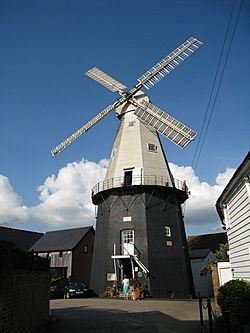Union Mill, Cranbrook facts for kids
Quick facts for kids Union Mill, Cranbrook |
|
|---|---|

The mill with traditional sails restored
|
|
| Origin | |
| Mill location | The Hill, Cranbrook, Kent |
| Grid reference | TQ779359 |
| Coordinates | 51°5′42.7″N 0°32′21.5″E / 51.095194°N 0.539306°E |
| Operator(s) | Kent County Council |
| Year built | 1814 |
| Information | |
| Purpose | Corn mill |
| Type | Smock mill |
| Storeys | Three-storey smock |
| Base storeys | Four-storey base |
| Smock sides | Eight-sided |
| No. of sails | Four |
| Type of sails | Double Patent sails |
| Windshaft | cast iron |
| Winding | fantail |
| Fantail blades | Eight |
| Auxiliary power | Steam 1863 - 1919 Gas engine 1919 - 1954 Electric motor since 1954 |
| No. of pairs of millstones | Three pairs |
| Size of millstones | 4 feet (1.22 m), 4 feet 4 inches (1.32 m) and 4 feet 6 inches (1.37 m) diameter. |
| Other information | The tallest smock mill in the United Kingdom. |
Union Mill is a very important historic building in Cranbrook, Kent, England. It is a type of windmill called a smock mill. This mill has been fixed up and can work again. It is also the tallest smock mill in the whole United Kingdom!
Contents
History of Union Mill
Building the Mill
Union Mill was built in 1814. A millwright (someone who builds and repairs mills) named James Humphrey built it. It was for a woman named Mary Dobell. Her son, Henry, was the first person to operate the mill.
How the Mill Got Its Name
In 1819, Mary Dobell had money problems. A group of people she owed money to took over the mill. This group was like a "union" of her creditors. That's how the mill got its name, Union Mill.
Changing Owners and Restoration
In 1832, the mill was sold to John and George Russell. The Russell family owned and ran the mill for five generations. They kept it going for a very long time! In 1957, the last miller from the Russell family retired. Kent County Council then bought the mill.
Work to fix up the mill started in 1958. It was finished in 1960 and cost about £6,000. A special event was held to celebrate the mill working again.
Mill Challenges and Repairs
In 1994, a big storm hit the mill. The fantail (a small windmill at the back that turns the main sails into the wind) was blown off. It damaged the main sails as it fell.
In November 2010, the mill got a new coat of paint. A team of workers from WallWalkers painted it. They used abseiling (climbing down ropes) to reach the high parts of the mill. This was a clever way to paint without needing huge scaffolding all around the mill.
What Union Mill Looks Like
Mill Structure and Height
Union Mill is very tall, standing seven storeys high. It has a three-storey smock (the top part that looks like a smock or dress). This smock sits on a four-storey brick base. The base includes a basement, ground floor, first floor, and second floor.
When it was built in 1814, the mill cost £3,500. The very top of the mill's cap roof is about 72 feet (21.95 m) high.
Sails and Machinery
The mill first had simple sails and a wooden shaft that held them. In 1840, a millwright named Samuel Medhurst made some changes. He put in a strong cast-iron shaft and special "patent sails." These sails are 68 feet (20.73 m) wide. The inside parts of the mill, which were made of wood, were also replaced with cast iron.
A few years later, a fantail was added. This gave the mill the look it has today. In 1863, a 10 horsepower (7.5 kW) steam engine was added. This engine helped power the mill. It also allowed the mill to use an extra pair of millstones.
Upgrades Over the Years
In 1880, the wide wooden platform around the mill was replaced. A narrower iron one was put in its place. This was because the patent sails didn't need the wide platform.
The steam engine was replaced in 1890. After a year or two, another steam engine was installed. In 1919, a gas engine took its place. The mill also got new sails from other windmills over the years. For example, sails from Sarre Windmill were fitted in 1920.
The mill had three pairs of millstones. These included a pair of 4 feet (1.22 m) diameter millstones, a pair of 4 feet 4 inches (1.32 m) diameter French Burr millstones, and a pair of 4 feet 6 inches (1.37 m) Peak millstones.
The mill stopped grinding flour in the early 1930s, but then started again. The gas engine was replaced by an electric motor in 1954.
Millers of Union Mill
Here are some of the people who worked as millers at Union Mill:
- Henry Dobell 1814-19
- John Russell 1832–73
- Ebenezer Russell 1875 -
- Hugh Russell -
- Caleb Russell 1902-18
- John Russell 1918-57
- Henry Hicks 1960 -
John Russell (who lived from 1888 to 1958) was a very special miller. In 1935, he received the first-ever award from the Society for the Protection of Ancient Buildings (SPAB). He got it for how well he took care of his mill.
Machinery Inside the Mill
The four patent sails are held by strong wooden stocks. When the mill was fixed up in the 1950s, a millwright from the Netherlands helped. He made the stocks in a Dutch style. These stocks worked well for over forty years.
The stocks go through a part called the canister on the cast-iron windshaft. This shaft holds the brake wheel. The brake wheel turns the wallower, which is at the top of the upright shaft. The upright shaft also powers a sack hoist (a lift for sacks of grain).
At the bottom of the upright shaft is the great spur wheel. This wheel used to turn three pairs of millstones, but now only two remain. These millstones grind the grain from above. A crown wheel also helped power other machines in the mill.


